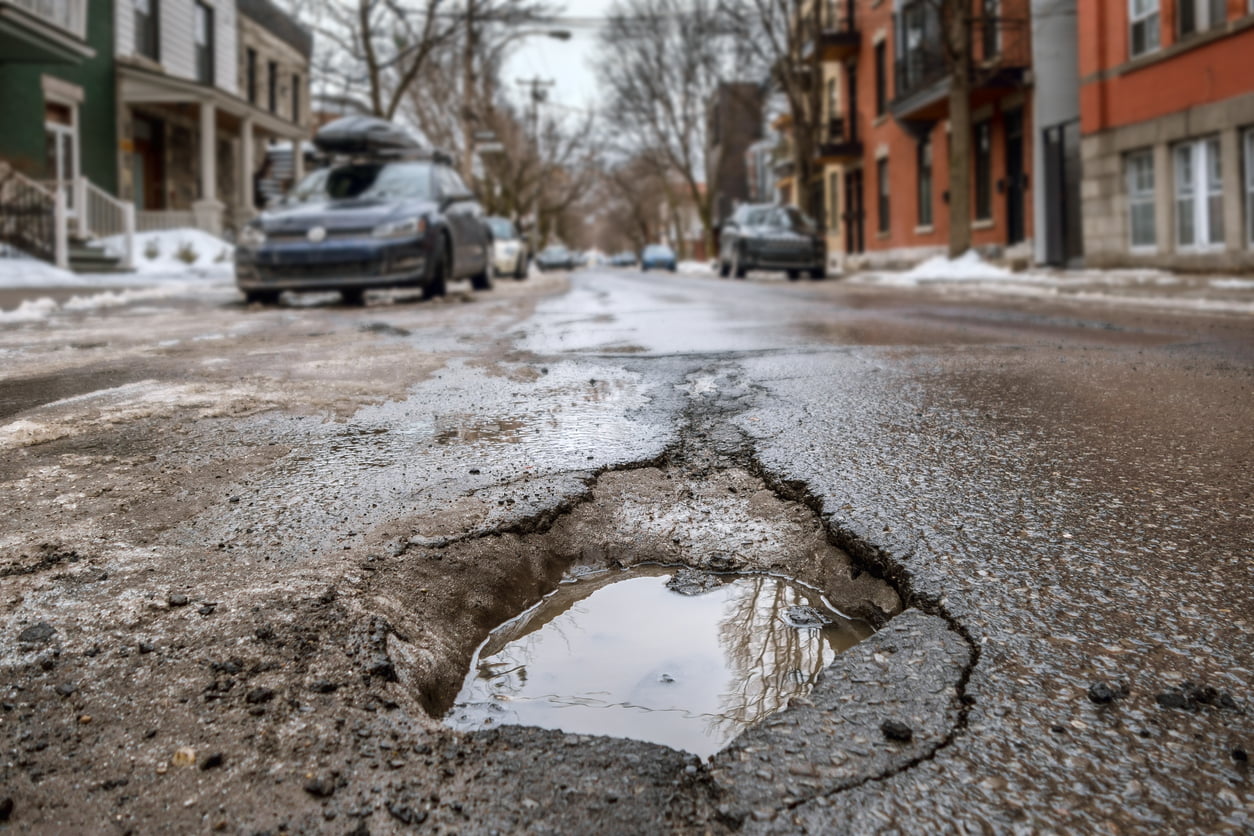After weeks of freezing and thawing temperatures, the shifting weather is causing a surge in pothole sightings across the city. With increased reports of potholes, claims of damages caused by potholes are also on the rise. Numerous vehicles are being towed in on a daily basis with anything from tire damage to severe suspension or steering issues. But who is responsible for paying for these damages? Let’s examine how you can claim damages caused by potholes in Ontario.
Potholes are unavoidable this time of year. The freeze-thaw temperatures and melting snow cause cracks to form in the asphalt. These cracks can turn a once smooth road surface into a minefield of depressions and holes. Since potholes form in the areas of the roadway where people drive, there is a chance your vehicle might encounter one. If you experience a bump or even receive serious damage to your steering, alignment or suspension, it can be a huge headache. If this happens while you are driving in Toronto, you can submit a claim for damages within 10 days of the date of the incident.
When you encounter a pothole
Road users and business owners can help by reporting potholes when you see them. It’s reported that crews repair potholes within four days of it being reported.
If you want to report potholes on City of Toronto roads or expressways, you can submit a service request by:
- Filling out an online form here
- Calling 311 and providing them with the exact location of the pothole
- Tweeting 311, with exact location of the pothole
- Emailing [email protected]
The city identifies potholes through regular patrols and reports made by the public to 311. If you see a pothole on a city street, call 311 or report it online. Please note by reporting a pothole online to 311, you are not submitting a damage claim to the City of Toronto.
Types of car damage as a result of potholes
If you hit a major pothole and can tell that it has done damage to your vehicle, take photos of the damage and the pothole. Then, write down where the pothole is located. Contact your isure broker or your insurer’s claims service line right away as they can tell you what to do next. If you need to have your vehicle towed and/or repaired, your insurer can help with that, as well.
Signs of post-pothole damage might include:
- A pulling sensation in one direction
- Dents in your tires or rims
- Low tire pressure
Most new cars are built to withstand rough road conditions. However, hitting a very large or deep pothole can cause damage regardless. If you are traveling at a high speed or with inadequate tire pressure when this happens, you can damage your steering, suspension, or alignment systems. In the worst-case scenario, it could cause you to lose control of your vehicle and end up in a collision with another car on the road.
Claiming pothole damages through your insurance
Most car insurance policies will cover damage caused by a pothole — as long as you have the right coverage. Hitting a pothole is generally considered a “single vehicle collision.” Any damage done to your vehicle would either be covered by the collision coverage and all-perils coverage. However, these are optional coverages. So, if you opted out of both of these when you bought your policy, you will have to pay to repair the damage yourself.
When making a claim for damages caused by a pothole, you’ll have to pay the deductible for whatever part of your policy is covering the damage. If your insurer tries to seek reimbursement from the local government and they’re successful, there’s a chance that they may be able to get your deductible back for you at the same time. There’s a catch, however. You are responsible for paying the deductible first, so if you have a $500 or $1,000 deductible and the pothole damage is less than this amount, you should not make a claim. A collision claim for a pothole will also be deemed an ‘at-fault’ claim by your insurer, so make sure to consider your options before filing.
Making a claim for damages caused by potholes to the city
The city where your car hit the pothole may also pay for your vehicle’s damage. However, only if local rules for that city are met. For instance, Toronto has complex rules that determine whether the city will pay for damage resulting from potholes. You are required to submit a claim within 10 days of the the incident date.
In 2020, Toronto drivers made 1,761 pothole damage claims, significantly less than previous years. This is likely due to a decrease in driving during the pandemic, and the city paid around 25% of them. Fingers are being pointed at Toronto’s ageing infrastructure and bouts of severe weather. Some believe these weather conditions may be influenced by climate change. You can go to the city’s website to find the claim web form. Then, you must enter all pertinent information about the incident.
Be sure to give the location of the pothole, the date the incident happened, what damage you experienced, and whether you notified 311. This last step is an important one because the city can “…request any related service logs as part of the investigation.” The investigation will start with the information in the web form being submitted to the city’s insurance adjuster, ClaimsPro. Once an adjuster has been assigned, you may submit documentation, like photos and receipts.
Exceptions and exemptions for claiming damages caused by potholes
When making a claim, it’s important to note that the city will not be responsible for your property damage if it has met the Provincial “Minimum Maintenance Standards for Highways in the City of Toronto” (MMS).
The MMS comprises a series of standards for various aspects of road maintenance (patrolling, salting, clearing snow and pothole repair). These vary, depending on the speed limit and traffic volume on a particular roadway in accordance with the following standards:
- Potholes in higher speed roads and high-volume roads are to be repaired more quickly than ones on side streets
- On the busiest roads, the city repairs potholes in four days from the date they are reported
- On side streets, the city has 30 days to repair potholes
Important: The 400-Series Highways are under provincial jurisdiction, so the above claims process does not cover them.
Speak to your isure broker first
There are minimum standards for road maintenance (including potholes) that regulate how fast the city needs to fix them. It will depend on where they are located and their size. You should first speak to your isure broker before submitting a claim. The City of Toronto notes on its website, “Your insurance coverage may be more extensive than what you can recover from the City.”
In conclusion, the answer to who pays for damages caused by potholes is not a simple one. Knowing your auto insurance company’s responsibilities is most important, and your policy will outline what you are entitled to. Obligations of your city or other jurisdictions where you experience vehicular damage is also important. To help you determine who will cover your repair bill, speak to one of our isure representatives. Our brokers will explore the best options for having your pothole damages taken care of!




